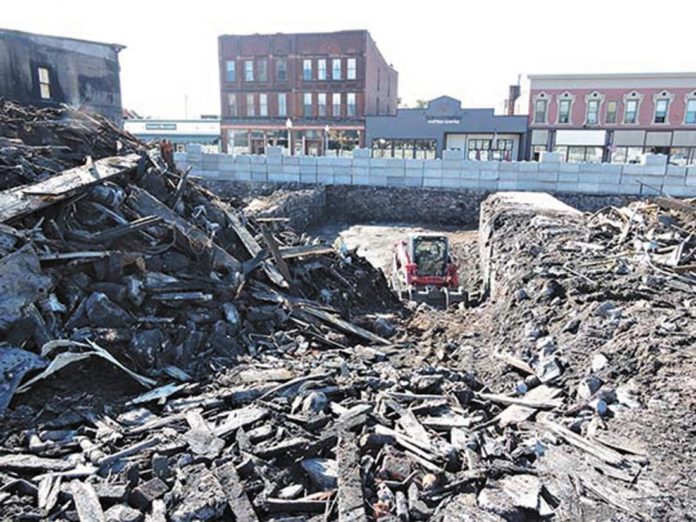
The Environmental Protection Agency cleanup project on Fifth Street is well into its third week as asbestos-containing debris is removed from the site of the May 21 fire that destroyed three buildings in the 100 block, including apartments. (Houghton Daily Mining Gazette photo by Graham Jaehnig)
<!–
CALUMET — Cleanup at the site of the May fire on Fifth Street is now in its third week, said Brian Kelly, Federal on-scene coordinator with the Environmental Protection Agency. The cleanup is to remove and dispose of asbestos-contaminated rubble and debris from the site.
“We were able to put together a project plan pretty quickly, considering the scale,” said Kelly.
In addition to the EPA’s own contractors, Kelly said sub-contractors have also been brought in, a local company. Kelly said since the project of removal has begun, more than 40 truckloads of the debris has been taken from the site, all fo which must be managed as asbestos-containing.
“We’ve set up air-monitoring, they monitor for dust and sample for asbestos,” he said. “We clearly don’t want to create a bigger problem than we’re dealing with.”
Kelly said that while executing the plan, he is actually acceding safety measures set by the EPA.
Asbestos is only a hazard when it is exposed and gets into the air, he said. So in removing the debris, it is placed in plastic-lined trucks. Copious amounts of water are used to keep the site wet to allay dust; there has been rain to help with that, and additionally, there are meters set up to take air samples. It is not a requirement to take perimeter air samples, Kelly said, but it is something that the EPA does. There is public housing in the vicinity, a public park, a coffee shop and apartments.
“We want to do this as safely as we possibly can,” he said. “This is in the heart of Downtown Calumet,” he said. “I mean, you don’t see them now, but earlier this summer, you saw fans up in the windows at the Keweenaw Coffee Works, you had people outside, and then you all this debris with asbestos in it, so clearly, this was a site that needed immediate attention.”
Exacerbating the situation, he said, were people trying to get scrap metal; there were some washers and dryers, and souvenirs.
“We really needed to do something,” Kelly said, so the EPA spoke with the village and the township, as well as the county, and learned that no one had the resources to begin an immediate removal project, and the EPA was able to do that.
There were several sources of asbestos in the debris, ranging from asbestos-containing vermiculite, as high as 30%; there were tiles containing asbestos, and furnace boilers that were wrapped with asbestos.
“It’s a fraction of what was in the material,” said Kelly, “but you can’t separate that out and it is mixed in there. We considered this urgent and that’s why we’re here.”
In regard to when the project will be completed, Kelly said there are some unknowns.
“What we don’t know is,” he said, “for example, there is a concrete slab over here and it broke. So, is there more basement beneath it?”
Within one to two weeks, the scrap will be gone, then back-filling the hole can begin.
“We can’t leave with a big hole in Downtown Calumet, that wouldn’t be safe,” said Kelly. “So, we’re going to work with the township and the village and county, to ask how can it be left for future redevelopment.
So far, he said, the project’s cost is somewhere between $600,000 and $700,000.
Kelly said he has been working in the Keweenaw area since approximately 2004. So far this year, he and his partner, Amy Kerranen, were at Gay doing cleanup, then to Julio’s property in Ripley. Then came the cleanup earlier this summer when an oil tanker dumped over on U.S. 41 in Hancock, then the Fifth Street site.
In an Oct. 5 email from the Chicago office of the EPA, Joshua Singer said that the EPA will monitor air quality during the cleanup and backfill open basements after the cleanup is completed this fall. Asbestos is a naturally-occurring mineral that was often used in construction in the mid-20th century. Breathing high levels of asbestos fibers for a long period of time can cause scar-like tissue to develop in the lungs and the lining surrounding the lungs.








